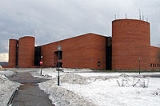
Orlov Museum
Encyclopedia
The Orlov Museum of Paleontology (Палеонтологический музей им. Ю. А. Орлова) was founded by Paleontological Institute of Russian Academy of Sciencies
in 1937 prior to the XVII session of the International Geological Congress. It is named after Yuri Alexandrovich Orlov (1893-1966).
It contains public exhibits representing almost every type of fossil
organism. Particularly well represented are dinosaur
s from Mongolia
, therapsids from the Perm
region of Russia
, and Precambrian
fossils from Siberia
.
 The museum started out as a branch of the Zoological Museum of Moscow University
The museum started out as a branch of the Zoological Museum of Moscow University
. When originally founded in 1937, the museum occupied 700 sq. m. in a building on Bolshaya Kaluzhskaya Street
.
During the German-Soviet War the museum was closed and the major part of collection relocated to Alma-Ata.
In 1944 museum was reopened for the general public, but in 1954 it was closed again due to the shortage of display space. In 1965 the USSR Council of Ministers granted 2 million ruble
s for the construction of the new museum building. However, construction works started only in 1972. The renewed museum met the first visitors in 1987.
Paleontological Institute of Russian Academy of Sciencies
The Paleontological Institute, Russian Academy of Sciences in Moscow is among the world's largest paleontological institutes. An affiliate of the Russian Academy of Sciences, it includes collections from all over the former Soviet Union, as well as from other countries.- Museum :The Museum of...
in 1937 prior to the XVII session of the International Geological Congress. It is named after Yuri Alexandrovich Orlov (1893-1966).
It contains public exhibits representing almost every type of fossil
Fossil
Fossils are the preserved remains or traces of animals , plants, and other organisms from the remote past...
organism. Particularly well represented are dinosaur
Dinosaur
Dinosaurs are a diverse group of animals of the clade and superorder Dinosauria. They were the dominant terrestrial vertebrates for over 160 million years, from the late Triassic period until the end of the Cretaceous , when the Cretaceous–Paleogene extinction event led to the extinction of...
s from Mongolia
Mongolia
Mongolia is a landlocked country in East and Central Asia. It is bordered by Russia to the north and China to the south, east and west. Although Mongolia does not share a border with Kazakhstan, its western-most point is only from Kazakhstan's eastern tip. Ulan Bator, the capital and largest...
, therapsids from the Perm
Perm
Perm is a city and the administrative center of Perm Krai, Russia, located on the banks of the Kama River, in the European part of Russia near the Ural Mountains. From 1940 to 1957 it was named Molotov ....
region of Russia
Russia
Russia or , officially known as both Russia and the Russian Federation , is a country in northern Eurasia. It is a federal semi-presidential republic, comprising 83 federal subjects...
, and Precambrian
Precambrian
The Precambrian is the name which describes the large span of time in Earth's history before the current Phanerozoic Eon, and is a Supereon divided into several eons of the geologic time scale...
fossils from Siberia
Siberia
Siberia is an extensive region constituting almost all of Northern Asia. Comprising the central and eastern portion of the Russian Federation, it was part of the Soviet Union from its beginning, as its predecessor states, the Tsardom of Russia and the Russian Empire, conquered it during the 16th...
.
History

Zoological Museum of Moscow University
The Zoological Museum of Moscow University is the second largest zoological museum in Russia and one of the twelve largest in the world.The Museum was established in 1791 as a museum of Natural History...
. When originally founded in 1937, the museum occupied 700 sq. m. in a building on Bolshaya Kaluzhskaya Street
Leninsky Prospekt, Moscow
Leninsky Avenue is a major avenue in Moscow, Russia, that goes from Oktyabrskaya in the central part of the city to Yugo-Zapadnaya in the outskirts....
.
During the German-Soviet War the museum was closed and the major part of collection relocated to Alma-Ata.
In 1944 museum was reopened for the general public, but in 1954 it was closed again due to the shortage of display space. In 1965 the USSR Council of Ministers granted 2 million ruble
Ruble
The ruble or rouble is a unit of currency. Currently, the currency units of Belarus, Russia, Abkhazia, South Ossetia and Transnistria, and, in the past, the currency units of several other countries, notably countries influenced by Russia and the Soviet Union, are named rubles, though they all are...
s for the construction of the new museum building. However, construction works started only in 1972. The renewed museum met the first visitors in 1987.

